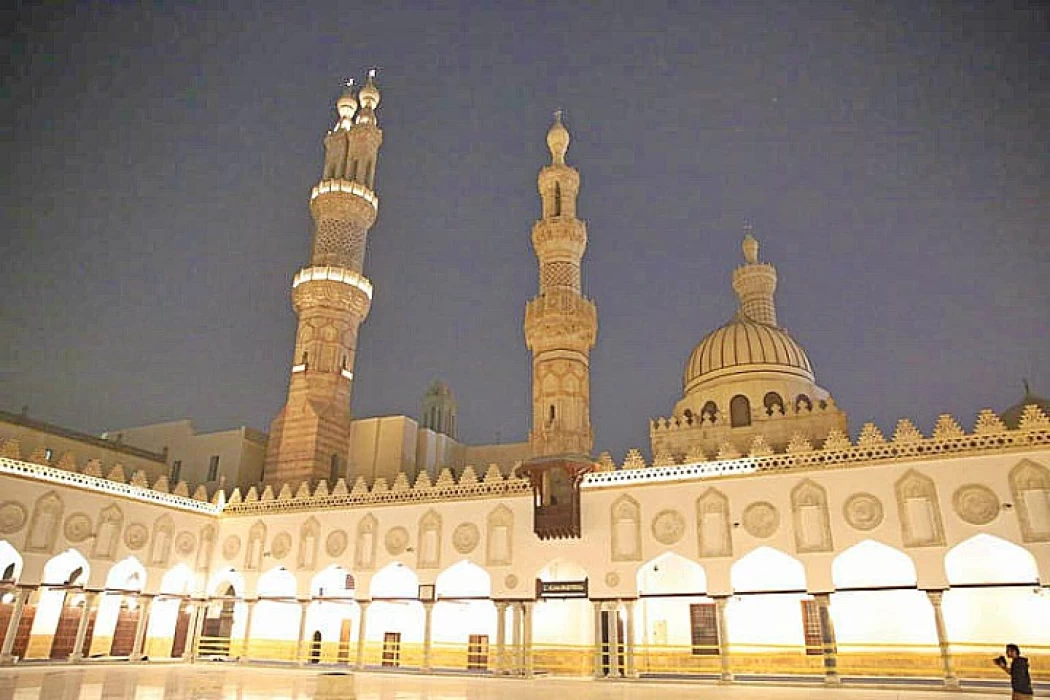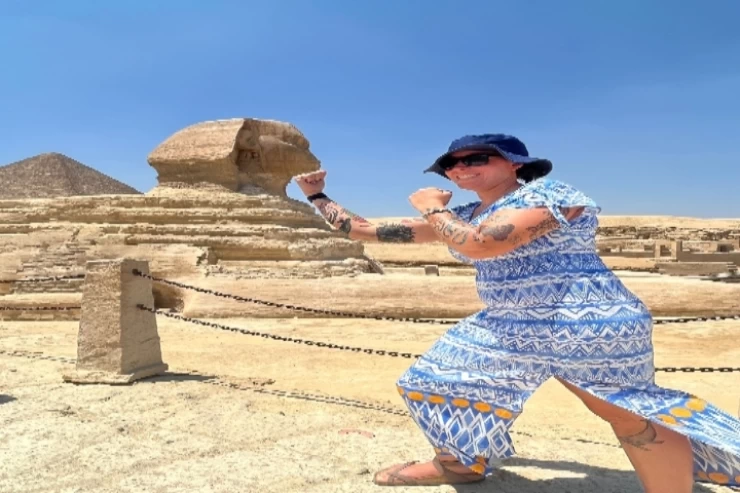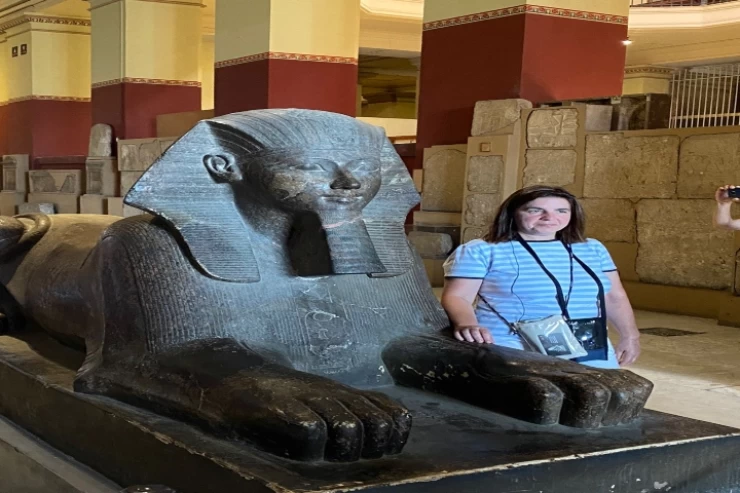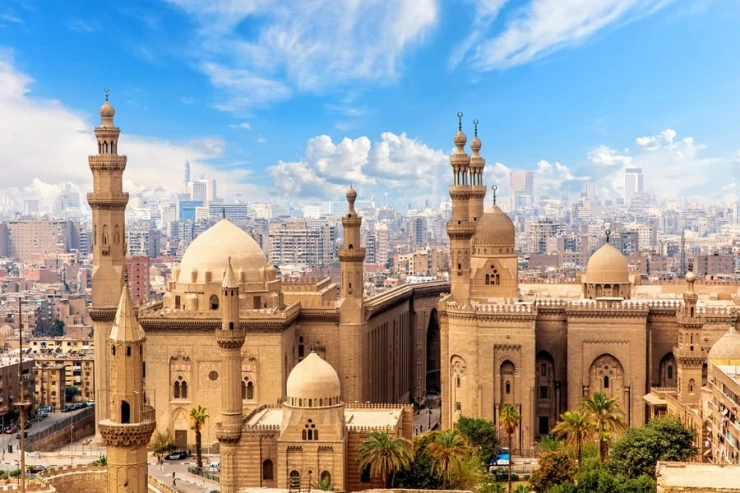
Mezquita Al Azhar
La mezquita Al Azhar fue la primera universidad islámica construida en El Cairo. Las personas que visitan Khan El Khalili pueden ver la mezquita durante sus Tours de un día en El Cairo. Fue construido hace aproximadamente 1,000 años y fue la mezquita oficial para la oración del viernes (jummah) durante muchos años en Egipto. Fue construido por el gran líder del ejército fatimí y el constructor de El Cairo, Gawhar El Seqelly, con las órdenes del califa fatimí, Al Mui'z le Din Allah. La construcción de Al Azhar comenzó en 970 d.C. y se terminó tres años después.
Diseño arquitectónico de la mezquita Al Azhar:
Al Azhar era originalmente la mitad del tamaño que tiene hoy. Se realizaron adiciones, nuevos edificios y restauraciones durante varias épocas hasta que la mezquita alcanzó el tamaño y la forma que tiene hoy. La primera mezquita de Al Azhar consistía en tres iwnas (salas de oración) centradas alrededor y un sahn (patio al aire libre). La puerta de la mezquita estaba ubicada en las paredes occidentales de la mezquita y esta sección contenía un simple minarete de estilo fatimí. Esta sección fue decorada con escritos islámicos de Kofy y ornamentos de plantas que son la única característica restante de la antigua mezquita que todavía está disponible ahora.
El viejo Mihrab de la mezquita estaba ricamente decorado con adornos y escritos de Kofi del Noble Corán. También hay una cúpula de estilo mameluco que se remonta al siglo XV, que tomó el lugar de la cúpula fatimí. Al Azhar tenía tres puertas en sus muros norte, sur y oeste. El menbar original construido por Gawher El Seqqely fue luego transferido a la Mezquita de Al Hakim. Cuando se construyó la mezquita, el Imam solía pronunciar su discurso del viernes una semana en la mezquita Al Azhar, otra en la mezquita de Al Hakim, otra en la mezquita de Ahmed Ibn Tulun y otro viernes en la mezquita Amr Ibn El Aas .
Mezquita Al Azhar en el período fatimí
Al Azhar sufrió muchos cambios en el período fatimí. Al Hakim Be'amr Allah agregó 27 increíbles lámparas de plata a la mezquita. Lo que queda de las obras de Al Hakim es una pequeña puerta de madera que está ricamente decorada con escritos de Kufi, que fue la característica de decoración dominante de esta época. En 1125 dC, el gobernante fatimí Al Amer be'ahkam Allah estableció un Mihrab para la mezquita (un nicho que indica en qué dirección rezar hacia Ka'aba) hecha de madera turca Aro que estaba decorada con muchas formas florales y geométricas. .
En 1149 d.C., el califa fatimí, Al Hafez Le Dine Allah quería expandir el tamaño de la mezquita, por lo que agregó algo de espacio al sahn de la mezquita. También agregó algunas decoraciones a las paredes de la mezquita y agregados de yeso.
Al Azhar en el período mameluco:
en 1266 d.C., Al Zaher Baybars ordenó construir un minbar ornamentado (púlpito), pero desafortunadamente no queda nada de él excepto sus instrucciones escritas para su construcción que ahora se guardan en un museo en Argelia.
Una nueva madrasa (escuela religiosa), la institución de enseñanza islámica Tabrisy Madrasa, fue construida por Baybars Khazendar, el comandante del ejército en el reinado de Al Nasser Mohamed Ibn Qalaun. Se encuentra a la derecha cuando ingresas a la mezquita Al Azhar. Esto agregó un espacio más grande a la mezquita que albergaba clases de enseñanza islámica y también tenía una gran biblioteca islámica.
Al Azhar en la era otomana:
Al Azhar experimentó una gran expansión en la era otomana. El trabajo de construcción más grande e importante fue d
El Afghaweya Madrasa fue construido en 1340 d.C. y se encuentra en el lado izquierdo de la entrada. Contiene la biblioteca de Al Azhar en la actualidad. uno por el Amir Abdel Rahman Katkhuda en 1753 d.C., ya que amplió el área de la mezquita agregando un riwaq (pórtico) detrás del mihrab que se construyó en un nivel más alto que toda la mezquita. También agregó un nuevo minbar y mihrab. Katkhuda también agregó dos grandes puertas: la primera en el muro sur llamada la puerta Sa'ayda y la puerta Shroba en la sección oriental de la mezquita con un minarete adicional al lado. Katkhuda también fue responsable de construir la hermosa puerta occidental con sus increíbles decoraciones islámicas y que ahora es la entrada principal de la mezquita.
Al Azhar también ha sido restaurado por el consejo supremo de antigüedades en los tiempos modernos. Al Azhar como mezquita y como institución educativa ha jugado un papel importante en tantos siglos de historia egipcia, especialmente en la lucha contra la ocupación francesa y británica.
La Universidad del Al Azhar:
La Universidad Al Azhar es la institución de enseñanza islámica más grande e importante en todo el mundo y es la segunda universidad islámica moderna que se construye. La enseñanza islámica en la Universidad Al Azhar se transformó de la enseñanza chiíta a la enseñanza sunita a partir de la era fatimí y sigue siendo una de las instituciones educativas más importantes y prestigiosas en Egipto y en todo el mundo.
En Egipto existe un lugar especial llamado Turismo En Asuán. Es un lugar donde se puede aprender sobre la cultura y la historia de El Cairo islámico.
Al Azhar Mosque |
Al Azhar house of prayer is one of the wonderful mosques and things to do in Cairo, it considered is the primary University in history engineered over one thousand years past in Cairo, folks visiting Khan El Khalili can see the house of prayer throughout their Cairo Day Tours. it had been towards the tip of the tenth century to be the official house of prayer for the congregational prayers control each Friday and is thought in a very rabic as Jummah.
The developer of the fascinating house of prayer of Al Azhar is as previous because the town of Cairo itself is additionally the good Fatimid army leader and also the builder of Cairo, Gawhar El Seqelly, with the orders of the Fatimid caliph, Al Mui'z le Din Allah. The building of Al Azhar that needs to be seen throughout the regular Egypt Travel Packages or Cairo day tours from the Airport began in 970 A.D. and it took around 3 years to be accomplished.
Architectural style Of Al Azhar Mosque: Initially, Al Azhar has engineered on 1/2 of the realm it occupies presently. Enlargements, new buildings, and restorations are meted out by many Caliphs, kings, sultans, and presidents of Egypt throughout the varied eras till the house of prayer reached the dimensions and the form it's nowadays. the first house of prayer of Al Azhar consisted of 3 Iwans or prayer halls, and within the center, there's an associate degree open court known as Sahn. the doorway to the house of prayer was set in toward the West and this section contained a straightforward tower or as known as in Muslim design tower designed within the Fatimid style. This section was adorned with Kofi Muslim inscriptions and floral motives, which are the sole remaining feature of the traditional house of prayer that's still obtainable currently.
However, the biggest design of the Al-Azhar house of prayer was performed by “Abd al-Rahman bin Katkhuda” within the year (1167 AH = 1753 AD) and he was keen on building and construction.
Then he else to the corridor of the qiblah a brand new prayer compartment separated from the initial compartment by stone pillars, and 3 steps rise from it, And it's 3 mihrabs, and established an oversized door from the northwestern aspect that presently overlooks Al-Azhar sq., consisting of 2 adjacent doors, referred to as the Gate of Muzain, and conjointly introduced a brand new door known as the Gate of Al-Sa'idah and created a tower beside it that also exists so far, and this door results in the Al-Sa’idah months. The corridors of Al-Azhar.
Al Azhar house of prayer within the Fatimid amount
Perhaps the primary design introduced to Al-Azhar was meted out by the Fatimid caliph, to preserve the faith of God, in Islamic Cairo, wherever he enhanced the realm porticos; within the Mamluk era, the sultans took care of Al-Azhar once the neglect it suffered within the Ayyubid era, and patrician “Izz al-Din Aydar was the primary to worry concerning Al-Azhar, thus he revived the elements that were cracked from him. And in its splendor, life came to an associate degree finish once a chance, and also the folks celebrated the Friday prayers in it on the day (18 Rabi` al-Awwal year 665 AH = nineteen Gregorian calendar month 1266AD). which will be seen nowadays within the depository of Muslim Arts throughout Egypt day tours in Cairo. In 1125 A.D., the Fatimid ruler Al Amer Be'ahkam Supreme Being established a Mihrab for the house of prayer (a niche that indicates that thanks to praying towards Ka'aba) created out of Aro Turkish wood that was adorned with loads of floral and geometric shapes.
Al Azhar within the Mamluk Period:

The design of the Al-Azhar house of prayer failed to stop throughout the reign of the Circassian Mamluks, wherever grand Turk Qaitbay Al-Mahmoudi (873 AH = 1468 CE) razed the door on the northwestern aspect of the house of prayer, engineered it once more because it is currently, and engineered on its right a sleek tower of the foremost lovely minarets of Cairo, Then grand Turk Qansuh al-Ghuri engineered the two-headed tower, the very best of the minarets of Al-Azhar, a novel variety of the tower that's rare within the Muslim world.
A new madrasa (religious school), the Tabrisy religious school Muslim teaching establishment, was engineered by Baybars Khazendar, the military commander during the reign of Al Nasser Mohamed Ibn Qalaun. it's set to the proper hand after you enter the Al Azhar house of prayer. This else a much bigger house than the house of prayer that hosted Muslim teachings categories and conjointly had an oversized Muslim library.
The Afghaweya religious school was inbuilt in 1340 A.D. and it's set on the left-hand aspect of the doorway. It contains the library of Al Azhar nowadays.
Al Azhar underwent plenty of growth within the Ottoman era. the {most important|the largest} and most important building work was done by the ruler Abdel Rahman Katkhuda in 1753 A.D. as he expanded the world of the house of prayer by adding a Riwaq (portico) behind the mihrab that was engineered on the next level than the full house of prayer. He additionally added a new minbar and mihrab. Katkhuda additional 2 nice gates as well: the primary within the southern wall referred to as the Sa'ayda gate and therefore the Shroba gate within the section of the house of prayer with an added minaret beside it. Katkhuda was additionally liable for building the attractive western gate with its superb Muslim decorations and that is currently the entrance of the house of prayer.
Al Azhar has been additionally renovated by the supreme council of antiquities to finally appear as if this within the trendy time throughout your visits to the house of prayer through the assorted Cairo overnight tours. Al Azhar as a house of prayer and as an academic establishment has to compete for a significant role in numerous centuries of Egyptian history, particularly in fighting the French and British occupation.


















